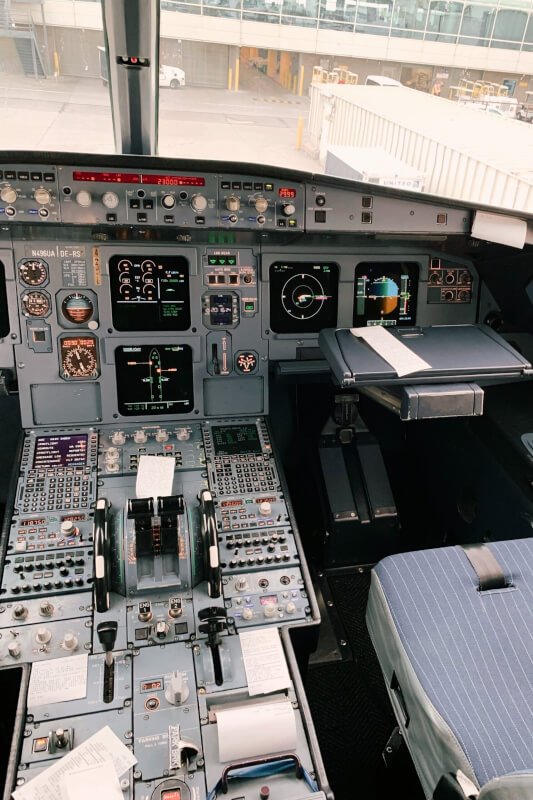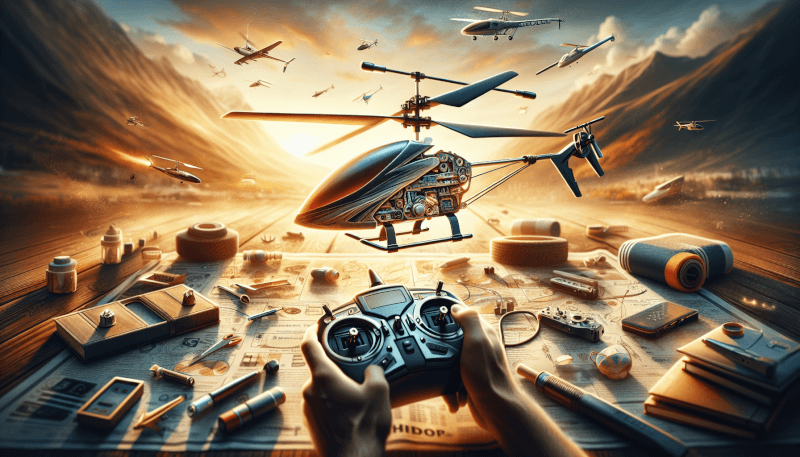Ready to take to the skies with your very own RC helicopter? Whether you’ve always dreamed of piloting one of these amazing machines or are simply looking for a new hobby to try, this article is here to help. In this ultimate beginner’s guide, you’ll learn everything you need to know to get started with flying RC helicopters, from choosing the right model to mastering basic flight maneuvers. So buckle up, grab your remote control, and get ready for an exhilarating adventure in the world of RC helicopters!

Choosing the Right RC Helicopter
When it comes to choosing the right RC helicopter, there are a few key factors to consider. First and foremost, you need to think about the size and type of helicopter that will best suit your needs. RC helicopters come in various sizes, ranging from small indoor helicopters to larger outdoor models. The size of the helicopter will determine where you can fly it and the type of flying experience you can expect.
Next, you’ll need to decide between a Ready-to-Fly (RTF) or a Bind-N-Fly (BNF) helicopter. RTF helicopters come fully assembled and are ready to fly right out of the box, making them ideal for beginners. On the other hand, BNF helicopters come without a transmitter and require you to bind them to a compatible transmitter before you can fly. This option is more suitable for those who already have a compatible transmitter or prefer to choose their own.
Another aspect to consider is the flight modes and features that the RC helicopter offers. Some helicopters have different flight modes that cater to different skill levels, such as beginner, intermediate, and advanced. Additionally, certain helicopters may come equipped with features like altitude hold, auto-hover, or even FPV (First Person View) capabilities. These features can enhance your flying experience and provide you with more control over the helicopter.
Of course, budget is always an important consideration. RC helicopters can vary significantly in price, with options available for every budget. It’s important to set a realistic budget and find a helicopter that meets your needs without breaking the bank. Keep in mind that you may also need to factor in the cost of additional accessories such as spare parts, batteries, and a charger.
Understanding RC Helicopter Controls
Before taking to the skies with your new RC helicopter, it’s essential to understand the various controls and components that make it all possible. The most crucial components are the transmitter and receiver. The transmitter is the remote control you hold in your hands, while the receiver is installed in the helicopter and receives the signals from the transmitter.
Each channel on the transmitter is responsible for controlling a specific function of the helicopter, such as throttle, pitch, roll, and yaw. Understanding the channel assignments is important as it will allow you to properly control your helicopter during flight.
Control surfaces, also known as servos, are responsible for moving the different parts of the helicopter, such as the main rotor, tail rotor, and cyclic control. These servos translate the input from the transmitter into the corresponding movements of the helicopter.
Dual rates and exponential settings are other important aspects of RC helicopter controls. Dual rates allow you to adjust the sensitivity of the controls, which can be helpful when transitioning from beginner to advanced flying. Exponential settings, on the other hand, allow you to adjust the response curve of the controls, providing a more gradual or aggressive response depending on your preference.
Finally, throttle hold is a safety feature that allows you to instantly cut off power to the main rotor. This feature is particularly useful in emergency situations or when you need to land the helicopter quickly and safely.
Preparing for Flight
Before taking your RC helicopter for its maiden flight, there are a few key steps to follow to ensure everything is in order. First, it’s crucial to check the helicopter for any visible damage or loose parts. Inspect the main rotor blades, skids, canopy, and other components to ensure they are secure and in good condition.
Next, make sure to charge the helicopter’s batteries fully before flying. It’s recommended to use the charger that comes with your helicopter or one specifically designed for your battery type to prevent any damage or safety issues.
Calibrating the controls is another crucial step before taking off. This ensures that the transmitter and receiver are properly synchronized, allowing for accurate and responsive control. Follow the instructions in your helicopter’s manual to calibrate the controls correctly.
Safety should always be a top priority when flying RC helicopters. Make sure to choose a safe and open area for flying, away from people, animals, and obstacles. It’s also important to follow any local regulations and guidelines regarding RC flying. Always keep a safe distance between the helicopter and yourself or others to prevent accidents.
Learning the Basics of Flight
Once you’ve prepared your helicopter for flight, it’s time to start learning the basics of flying. Hovering is often the first skill beginners focus on mastering. It involves keeping the helicopter stable and stationary in the air, without any forward or backward movement. Practice maintaining a steady hover at various heights to develop your control and stability.
Takeoff and landing are also essential skills to learn. Practice taking off smoothly and landing softly without any sudden movements. This skill is crucial for safe and precise control during flight.
Once you’re comfortable with hovering, you can start practicing forward and backward flight. Slowly increase the throttle to move the helicopter forward, and then decrease it to move backward. It’s important to maintain a smooth and steady flight path while practicing this maneuver.
Sideways flight adds another dimension to your flying skills. Gently move the cyclic controls to the left or right to make the helicopter move horizontally. Practice maintaining control and stability while flying in sideways directions.
Turning is another fundamental maneuver to practice. Use the yaw control to rotate the helicopter left or right. Start with small turns and gradually increase the angle as you become more comfortable. Remember to coordinate the throttle and cyclic controls while turning to maintain a smooth flight.

Mastering Advanced Maneuvers
Once you’ve built a solid foundation and are comfortable with the basic flight maneuvers, you can begin to explore more advanced maneuvers. Cyclic control inputs allow you to perform intricate movements such as flips, loops, and rolls. These maneuvers require precise control and coordination between the cyclic and collective controls.
Pirouettes are another impressive maneuver to learn. They involve rotating the helicopter on its yaw axis while maintaining control and stability. Practice both clockwise and counterclockwise pirouettes to improve your overall flying skills.
Inverted flight takes your flying abilities to a whole new level. It involves flying the helicopter upside down while maintaining control and stability. This maneuver requires careful coordination and practice, as the controls are reversed when the helicopter is inverted.
Performing figure 8s is a great way to showcase your flying skills. This maneuver involves flying the helicopter in a figure 8 pattern, transitioning smoothly from one direction to another. Practice maintaining a consistent flight path and smooth transitions during figure 8 flights.
Autorotation is an advanced maneuver that allows you to safely land the helicopter in the event of a power failure or emergency situations. It involves using the helicopter’s momentum to perform a controlled descent without power. Learning autorotation can be challenging but is an essential skill for any serious RC helicopter pilot.
Understanding Helicopter Maintenance
Taking care of your RC helicopter is important to ensure its longevity and optimal performance. Regular cleaning and lubrication of the helicopter’s moving parts can help prevent wear and ensure smooth operation. Use a soft cloth or brush to remove any dirt or debris, and apply a small amount of lubrication to the moving components as recommended by the manufacturer.
Inspecting the helicopter regularly is necessary to identify any worn or damaged parts that may need replacement. Check the rotor blades, main gears, and other critical components for any signs of wear or damage. Replace any faulty or worn parts promptly to maintain safe and reliable flight.
Proper battery care is essential for both the performance and lifespan of your helicopter. Follow the manufacturer’s instructions for charging, storing, and handling the batteries. Avoid overcharging or discharging the batteries and always use a charger specifically designed for your battery type.
When it comes to storing your RC helicopter, it’s important to keep it in a safe and secure location. Remove the batteries if the helicopter will be stored for an extended period and ensure it is protected from moisture, extreme temperatures, and dust.

Troubleshooting Common Issues
As with any hobby, RC helicopter flying can come with its fair share of challenges and problems. Understanding how to troubleshoot common issues can help you overcome obstacles and enjoy a smoother flying experience.
If you experience a crash, the first step is to remain calm and assess the damage. Inspect the helicopter for any visible damage and check if any parts need to be replaced. Some crashes may only result in cosmetic damage, while others may require more extensive repairs.
Trim adjustments are often necessary to fine-tune the helicopter’s flight characteristics. If your helicopter is experiencing drifting or showing an imbalance during flight, adjusting the trim settings can help correct these issues. Follow the instructions in your helicopter’s manual to make precise trim adjustments.
Radio interference can occasionally disrupt your flying experience. If you notice erratic behavior or loss of control, it’s possible that other electronic devices or nearby sources of interference are affecting your helicopter’s signal. Try relocating to a different flying area or adjusting the frequency settings to avoid interference.
Mechanical failures can occur, even with well-maintained helicopters. If you notice any unusual noises, vibrations, or sluggish movements, it’s important to inspect the helicopter thoroughly and identify the cause of the issue. It may be necessary to replace faulty or worn parts to restore the helicopter’s performance.
Battery problems can also arise, leading to reduced flight times or unstable performance. If you notice a sudden decrease in flight time or inconsistent power delivery, it’s essential to check the battery’s condition. Replace any old or damaged batteries to ensure optimal performance.
Joining the RC Helicopter Community
Joining the RC helicopter community can be a rewarding experience, providing opportunities to connect with fellow hobbyists, learn from experienced pilots, and participate in events and competitions. Local RC clubs and events often host social gatherings, workshops, and flying sessions, allowing you to meet and learn from other enthusiasts in your area.
Online forums and communities are another valuable resource for connecting with RC helicopter pilots from around the world. These platforms provide a space to ask questions, seek advice, and share your own experiences with a supportive and knowledgeable community. Be sure to contribute positively and respect the rules and guidelines of these online communities.
Learning from experienced pilots is an excellent way to expand your knowledge and improve your flying skills. Seek out mentors or instructors who can provide guidance and offer valuable tips and tricks. Flying with more experienced pilots can also expose you to new flying techniques and maneuvers, helping you progress in your RC helicopter journey.

Expanding Your RC Helicopter Skills
Once you’ve mastered the basics of flying and feel confident in your abilities, you may want to consider expanding your skills further. One way to do this is by upgrading to collective pitch helicopters. These helicopters offer a more advanced level of control, allowing for more complex maneuvers and aerobatics.
Learning 3D maneuvers is another exciting aspect of RC helicopter flying. 3D flying involves performing dynamic and acrobatic maneuvers such as flips, rolls, and inverted flight. It requires precise control and coordination between the cyclic and collective controls, as well as mastery of advanced flying techniques.
If you’re looking for a more competitive aspect, participating in RC helicopter competitions can be a thrilling way to showcase your flying skills. Competitions often involve precision flying, routine performances, and aerial challenges. They offer a chance to meet and compete with pilots of various skill levels, pushing yourself to new heights.
Conclusion
Reflecting on your journey as an RC helicopter pilot, you will likely recognize the significant progress you’ve made and the skills you’ve developed throughout the process. From choosing the right helicopter to understanding the controls and mastering advanced maneuvers, the journey of flying RC helicopters is incredibly rewarding.
Remember to continue learning and growing, seeking new challenges and opportunities to expand your skills. Whether it’s joining local RC clubs, engaging in online communities, or exploring new flying techniques, the RC helicopter hobby offers endless possibilities for fun and personal growth. So, embrace the adventure, enjoy the thrill of flight, and soar to new heights with your RC helicopter.



